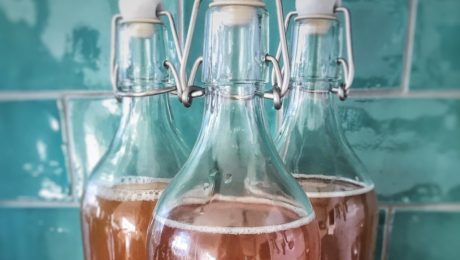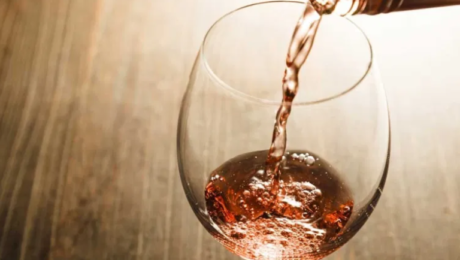Ireland’s Fermented Drinks Under Scrutiny
After a study found 91% of plant-based, fermented drinks in Ireland make unauthorized health claims, the Food Safety Authority of Ireland (FSAI) has published a guide on how to produce such beverages safely and label them accurately.
The FSAI examined 32 unpasteurized drinks currently sold on the Irish market – including kombucha, kefir and ginger soda – and found that most did not comply with EU and Irish food labelling and health regulations. The study found 13% had alcohol levels above labelling thresholds, and 75% lacked required label information, like the address of the producer and “best-before” date.
“The methods used in producing unpasteurized fermented plant-based products can be difficult to manage,” notes Dr. Pamela Byrne, FSAI chief executive. “The guidance will help producers to achieve consistent production methods, safe storage, safe handling and safe transportation of fermented beverages.”
Read more (Agriland)
Native American Brewery with Traditional Flavors
Bow & Arrow Brewing in New Mexico is part of two small but growing groups in the U.S. — it is both female- and Native American-owned.
Bow & Arrow locally sources their traditional Native American ingredients (blue corn, Navajo tea, three-leaf sumac) for their seasonal sour beers. The hops they use — subspecies neomexicanus — were used for their antiviral properties by the Navajo people in the Southwest,who put them in teas and salves. The brewery owners — Missy Begay and Shyla Sheppard — forage for hops in the mountains near Albuquerque. They also give their spent brewing grains to a local Native American family for use as feed for their livestock.
Begay, pictured left (who is Diné [Navajo]) and Sheppard, pictured right (a member of the Three Affiliated Tribes [Mandan, Hidatsa, and Arikara]) met at Stanford University in 2000. They took different career paths, but both fell in love with craft beer and homebrewing. They opened Bow & Arrow Brewing Co. in 2016.
“There is a sweetness to the land here, and all of this is sacred. We hope, as Native American women brewery owners, that people understand the story we have to tell,” Begay says.
Read more (Outside)
- Published in Business, Food & Flavor
Reviving Sake with SoCal Style
James Jin of Nova Brewing Co. doesn’t want to create a Japanese-style sake — he’s working to create a Southern Californian sake.
Jin uses Calrose rice grown near Sacramento, imports koji and yeast from Japan and designs his own brewing equipment. The flavor of his modern sake is thanks to a secret blend he uses to make the koji rice (the base for the sake), utilizing both yellow and black koji spores, as well as yeast from the Brewing Society of Japan. The flavor — more wine-like, fruitier, higher in acidity and easily paired with food — “it’s a lot more appealing to the younger generation.”
“I respect the history of sake brewing, but it’s a dying art in Japan,” Jin says, adding, “Sales of sake [are] constantly going down [there]. I’m one of the few brewers in America trying to bring the dying art back to life.”
“I’m not a Japanese brewer. I’m an American brewer. I purposefully do things they wouldn’t do in Japan.”
Nova Brewing produces four sakes and 10 craft beers at their facility in Covina, California. They are the only craft sake brewery and tasting room in Los Angeles County — and the only sake and beer hybrid producer in California.
Read more (Los Angeles Times)
- Published in Business, Food & Flavor
Post-Pandemic, Sales Plateaus for Fermentation Brands?
This is the first in a series of articles that TFA will be releasing over the next few months, analyzing trends from our Member Survey.
Though fermentation brands overwhelmingly reported substantial sales gains during the Covid-19 pandemic, they’re not breaking out the champagne. Now, nearing fall 2021, many are starting to see sales flatten. This trend is consistent with sales for the food industry at large, which started to plateau in March 2021.
Most fermenters reported struggles meeting demand — packaging shortages (38%), costly and time-consuming Covid-19 sanitation protocols (30%), distribution delays (29%) and ingredient and labor shortages (both 28%). Then there’s the challenge of keeping a fermented product in stock with constantly changing sales demands.
Jared Schwartz, a TFA Advisory Board member, is founder of fermented sauce producer Poor Devil Pepper Co. and director of operations and quality for Farm Ferments (a facility in Hudson, N.Y., that is home to Hawthorne Valley Farm). He says forecasting has been especially difficult for a refrigerated fermented food with a processing cycle more delicate than that of its shelf-stable counterpart.
“While these spikes in sales are incredible, they also depleted our on-hand WIP [Work-In-Progress],” Schwartz says. He would project barrels of fermenting vegetables to provide adequate inventory for a certain length of time, but peak pandemic demand depleted stock. Finding new ingredients is difficult because everything is sourced locally. “With fermentation, there is of course a much longer lead time on a finished product as the process can’t be rushed. So these challenges left us extending our production season and looking to source from the spot market, which is generally out of our norm. We generally source 95% of our ingredients from New York State and base our projections around the trajectory aforementioned.”
Sales Flatten After Record Year
While predicting sales has been difficult — especially as many states are again increasing Covid-19 restrictions because of the Delta variant — some brand leaders were prepared for a decrease in sales in 2021.
Kheedim Oh, founder of Mama O’s Kimchi (and also on TFA’s Advisory Board), said sales doubled in 2020. But, this summer, they fell dramatically from that peak. “July was terrible,” Oh says, but they “anticipate a boost in the fall since summer months are typically slower.”
Revenue almost tripled in 2020 for hard kombucha brand Dr. Hops, but sales have since started to flatten. The company had secured new distribution before the pandemic, then redesigned their product line this year. “We would have likely done much more… if we had been able to do all the field sales and marketing we had planned,” says Joshua Rood, co-founder and CEO of Dr. Hops Real Hard Kombucha,
Hawthorne Valley is seeing a similar downturn. Sales from March to April spiked about 50%, with overall year-over-year growth at 46%. But “things have definitely plateaued for now,” Schwartz says.
Supply Chain Nightmares
Small packaging supplies — like the tiny plastic caps for glass kombucha bottles — caused huge production issues. Hannah Crum, president of Kombucha Brewers International, says this was the biggest challenge for brewers. “It’s had a massive impact,” she says.
Twenty-four percent of survey respondents said they anticipate production constraints will continue to be a challenge throughout 2021.
And though sales remain strong for Bubbies pickles according to John Gray, owner of Bubbies (and TFA Advisory Board member), “glass shortages have affected the entire industry. Sales are strong, but shortages persist,” as he describes the pandemic’s double-edged sword facing many fermented brands.
Production and distribution issues hit frozen pizza brand Alex’s Awesome Sourdough, too — packaging costs went up 10%, and freight expense nearly doubled. But these didn’t slow the company’s growth. They expanded massively in 2020, from 100 to 1,500 stores. An overall uptick in frozen food sales helped them as well, especially as competing pizza brands went out of stock.
“Sales are strong as pizza is a seasonal category and the end of summer and early fall are the beginning of peak season,” says Alex Corsini, founder of Alex’s Awesome Sourdough (and another TFA Advisory Board member). “We anticipate sales being even stronger if Covid protocols remain strict and restaurants continue operating at a limited capacity. Restaurants definitely take a piece of our pie (pun intended).”
- Published in Business
Alcohol Levels in Wine Continue to Rise
The alcohol levels in wine have been rising over the past 30 years — and wine experts say the sugar content in grapes is to blame.
Though a winemaker can manipulate sugar levels in the vineyard and alcohol levels in the cellar, a hotter climate is driving increased sugar content in grapes. California’s wine grapes have had a “substantial rise” in sugar levels since 1980. A study by the American Association of Wine Economists (AAWE) hypothesizes global warming is contributing.
Read more (Decanter)
- Published in Food & Flavor
U.S. Celebrities Infiltrate Mexico’s Tequila Industry
Tequila sales last year were 60 million gallons, 800% higher than two decades ago. This agave-based spirit has become so popular that distillers are “selling it at the price of gold.” What caused the boom? Celebrity endorsements.
From George Clooney to Arnold Schwarzenegger, LeBron James to Nick Jonas and Dwayne “The Rock” Johnson to Kendall Jenner, celebrities have made billions off their tequila brands.
A Los Angeles Times article highlights the pros (a booming local economy in Mexico, tequila being introduced to more people) and the cons (environmental concerns, agave plants harvested too young, diverse crop fields and forests turned into monocultures of agave, foreigners taking over a traditional drink) of this growth. The article continues:
“Pre-Hispanic Indigenous groups in Mexico had been fermenting agave into a viscous alcoholic drink known as pulque for centuries when Spanish conquistadors arrived in the 16th century and first distilled tequila. It has since evolved into an $10.8-billion-a-year industry.”
Read more (Los Angeles Times)
- Published in Business
Japan’s Rich Culture of hakkо̄
“If there were a country whose cuisine excels in the realm of fermented foods, it’s Japan,” highlights an article in Discover Magazine. In Japan, hakkо̄ (which translates to “fermentation”) forms “the very basis of gastronomy in the island nation,” continues the article.
Tsukemono (pickles), miso (fermented soy bean paste), soy sauce, nattо̄ (fermented soy beans), katsuobushi (dried fermented bonito flakes), nukazuke (vegetables pickled in rice bran), sake and shōchū (liquor distilled from rice, brown sugar, buckwheat or barley) are all staples of traditional Japanese meals.
Nattо̄ in particular has been proven to lower obesity rates, boost levels of dietary fiber, protein, calcium, iron and potassium and reduce diastolic blood pressure.
Though the article highlights the few, limited studies on the effects of other fermented foods, it also noted how difficult it is to study them. There little money behind the study of traditional foods (outside of yogurt), and participants in any such research would need to be on the same diets and exercise programs in order to produce objective results. A study would also need to take place over multiple years — “the cost would be vast, the ethics questionable.”
Read more (Discover Magazine)
- Published in Food & Flavor
Beer’s Complex Makeup
German scientists have found at least 7,700 different chemical formulas — translating to tens of thousands of unique molecules — in 467 commercial beer types.. Researchers with Technical University of Munich (TUM) and Helmholtz Zentrum München, Neuherberg, Germany (HZM-Neuherberg) used state-of-the-art mass spectrometry techniques to reveal the vast metabolic complexity, according to a study published in Frontiers in Chemistry.
The beers tested came from all over the world — U.S., Latin America, Europe, Africa and East Asia — and were brewed with barley alone or from a mix of barley and wheat, rice or corn.
Of the distinct molecules discovered, 80% had not yet been described in chemical databases.
“We show that this diversity originates in the variety of raw materials, processing, and fermentation,” said first author Stefan Pieczonka, a PhD student at TUM. “This complex reaction network is an exciting focus of our research, given its importance for food quality, flavor, and also the development of novel bioactive molecules of interest for health.”
Read more (Tech Radar)
- Published in Science
Natural Production Changing the Wine Industry
Natural winemaking is moving mainstream, as more viticulturists preach the importance of soil health and shun traditional herbicides. “Where does natural wine finish and conventional wine start? These days, it’s hard to tell,” reads an article in Vinepair. Though the vast majority of global wine production still relies on conventional methods, the virtues of natural winemaking are helping change the industry.
“While it used to be rare for wines to be fermented with wild yeast — allowing the microbes present on the grapes to carry out fermentation — this is now much more common. And conventional producers have been prompted to question their use of additives such as sulfur dioxide. In fact, many aspects of winemaking that were championed by natural wine folk have now become much more common, even replacing some of the triumphs of more heavy-handed methods. As more producers trend away from making big, international-style reds with dark color, sweet fruit, high alcohol, and obvious new oak character, extracting less color and tannin for lighter-style reds is gaining popularity.”
Read more (Vinepair)
- Published in Food & Flavor
Picturing Traditional Sake
Hoping to spur interest in traditional sake, a Japanese producer has published a picture book What is Sake? that takes readers on a tour of their sake facility. Suigei Brewing Co., based in the western city of Kochi, uses the book to detail how sake is made. The bilingual book includes English translations.
The president of Suigei Brewing Co., Hirokuni Okura, notes Japan’s sake culture is gradually being forgotten. He said he desires to “have both adults and children view sake, an element of Japanese food culture, as something close to them.”
The book’s illustrator, Misae Nagai, featured all 53 employees of Suigei in her charming illustrations.
Read more (The Mainichi)
- Published in Business, Food & Flavor










